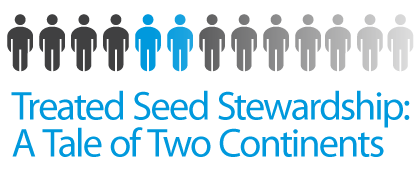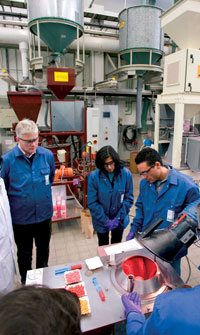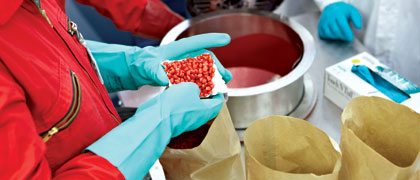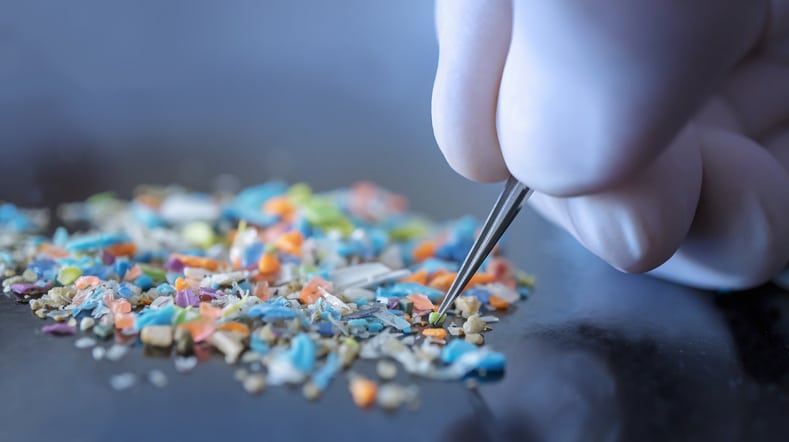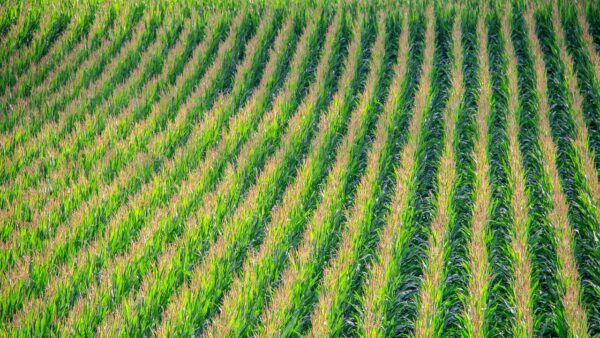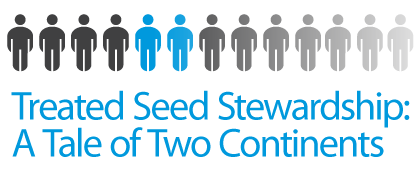
In the face of increasing scrutiny over the relationship between neonicotinoids and bee health, seed associations and other industry stakeholders in North America and Europe are taking action to enhance stewardship standards for treated seed and to further reduce environmental risks, especially to bees and other pollinators.
The treated seed market has been red-hot in recent years, with innovations in treatment types, active ingredients and new application technologies, leading to increased adoption by more farmers and for a growing array of crops. But as the use of treated seed has grown in North America, Europe and around the world, so has speculation about the possible impact of dust from insecticide-treated seed on the environment — particularly bees and other pollinators.
A series of scientific studies over the past few years have increasingly linked neonicotinoids — the chemical group of systemic insecticides that includes clothianidin, imidacloprid and thiamethoxam — found in some seed treatment products to negative effects on bee health. This has increased pressure on government regulators to step in and impose new rules on seed treatment handling and usage — or in some instances, forbid the use of neonicotinoid pesticides altogether.
In late April, the European Commission decided to press ahead with a ban on the use of neonicotinoid-containing products for most crops, despite the European Union’s 27 member states failing to reach an agreement on the matter. The two-year ban, which goes into effect Dec. 1, has been criticized by Germany-based Bayer CropScience and other neonicotinoid manufacturers.
An April press release from Bayer CropScience describes the ban as “a set-back for technology, innovation and sustainability.… The restriction of these neonicotinoids will result in crop yield losses, reduced food quality and loss of competitiveness for European agriculture. This will have a negative impact on farmers, R&D-driven ag companies, the seed industry and the food value chain.”
|
Customer training at Bayer CropScience’s SeedGrowth Center. |
The company says it remains convinced that “neonicotinoids are safe for bees, when used responsibly and properly, according to label instructions,” adding that “clear scientific evidence has taken a back-seat in the decision-making process. This disproportionate decision is a missed opportunity to reach a solution that takes into consideration all of the existing product stewardship measures and broad stakeholder concerns.”
The same class of neonicotinoids banned in Europe are also under review in Canada. The Pest Management Review Agency announced in June 2012 it was ordering a re-evaluation of clothianidin, imidacloprid and thiamethoxam insecticides for potential effects on pollinators.
“The re-evaluation will be conducted in co-operation with the United States Environmental Protection Agency as part of the work being done with international partners to better understand and manage potential risks to pollinators,” says Sara Lauer, media relations officer for Health Canada. “This is a complex re-evaluation that requires the development of new studies with bees, and may take several years to complete.”
With the ban in Europe, neonicotinoids under increasing scrutiny in Canada, and a coalition of beekeepers and environmental and consumer groups suing the U.S. EPA over its handling of clothianidin and thiamethoxam, it is understandable if some in the insecticide-treated seed sector feel besieged.
But for many others, this segment of the industry is by no means a lost cause — far from it. Prominent seed organizations such as the European Seed Association and the American Seed Trade Association as well as associations for the crop protection industry in Canada and the United States, CropLife Canada and CropLife America, have been working hard to debunk misconceptions and educate the public and government regulators about the agronomic, economic and environmental benefits of treated seed, as well as institute measures aimed squarely at minimizing and managing risks to bee health.
|
BMPs for seed-applied insecticides can be found at croplife.ca/issues/pollinators. |
BMPs for Planting Treated Seed
In this country, Health Canada has been working closely with growers, beekeepers, seed treatment facilities, and seeding equipment manufacturers to develop both short- and long-term strategies for protecting pollinators, including honey bees.
According to Lauer, the strategies include a guide titled Pollinator Protection and Responsible Use of Treated Seed: Best Management Practices, released in February, outlining BMPs for planting neonicotinoid-treated seed, which was “developed in consultation with a wide variety of stakeholders to ensure that the recommended practices were as practical and effective as possible and would be well received.”
Health Canada is closely monitoring the effectiveness of the BMPs during this planting season, Lauer says, adding that if necessary, the practices will be revised based on grower feedback on their practicality and effectiveness.
|
Pollinator Protection and Responsible Use of Treated Seed: Best Management Practices can be found at hc-sc.gc.ca/cps-spc/pubs/pest/_fact-fiche/pollinator-protection-pollinisateurs/treated_seed-semences_traitees-eng.php. |
Lauer also points to a growing number of industry-led initiatives in Canada aimed at protecting pollinators. “Longer-term strategies such as improved seed coatings, lubricants and seeding equipment continue to be developed by stakeholders,” she says.
One of those stakeholders is CropLife Canada, which in co-operation with growers, beekeepers and provincial government agricultural agencies has also developed a set of best management practices for the use of seed-applied insecticides posted on the CropLife Canada website in January, including a video on the topic.
Pierre Petelle, vice-president of chemistry with CropLife Canada, says another project is underway to develop safe handling protocols and recommendations for commercial seed treatment facilities. “Those will be finalized over the next year and brought into force in 2015,” he says.
Petelle believes these types of industry-led stewardship initiatives make a neonicotinoid ban, like that just imposed in Europe, unlikely to happen in Canada anytime soon.
“We think that industry taking initiative and demonstrating that it can regulate in these areas on its own certainly does avoid some of the interventions from governments,” he says. “In our opinion, the European decision wasn’t grounded in science — it was a political outcome. So we have full confidence that the scientific review being conducted by PMRA and EPA will yield a different result. We are fully confident that they will continue to support a science-based approach, and the science does support the safety of these products.”
European Seed Treatment Assurance Scheme
On the other side of the pond, the ESA also recognizes that ensuring the highest quality seed treatment is important to protecting the environment and reducing risks to pollinators. For this reason, it has spent the past two years developing the European Seed Treatment Assurance scheme, aimed at ensuring all parts in the seed treatment chain assume their respective responsibilities and put in place specific quality assurance measures.
“We want to establish good seed treatment practices throughout the industry in Europe that’s relevant to all treatments — not only for insecticides, but also for fungicides — and for all crops,” says Garlich von Essen, ESA’s secretary general.
The main features of the ESTA scheme are:
• Independent certification of seed treatment sites by accredited auditors
• Defined quality reference values with a uniform testing protocol
• Safe use handling and care information and product labelling for users
|
For more information on the ESTA, visit euroseeds.org/esta. |
Under this initiative, only certified seed treatment facilities can use the ESTA logo on their products to document compliance and facilitate the free movement of treated seed throughout the European Union. SGS Germany recently became the first company accredited by the ESA to carry out seed treatment audits for the certification of seed treatment plants.
“The accreditation of SGS as the first ESTA certifying body marks another important step in the implementation of the scheme. It shows that the concept is workable and that it is now being taken up in practice by the seed companies,” says von Essen.
“We’re fully supporting the ESTA scheme from ESA, and have been involved from the beginning,” says Martin Gruss, global head of SeedGrowth products for Bayer CropScience. “It is a good example of the growing commitment of the seed treatment industry in Europe to the high quality of treated seed.”
The ban on neonicotinoid applications, including seed treatment, for many crops will be in place across Europe in December. ESA, Bayer CropScience and other players in the treated seed industry have criticized the European Commission of being too reliant “on the precautionary principle, without taking the principle of proportionality into account.” They maintain that there is a long history of the safe use of neonicotinoid-based products, and that when used responsibly and properly any impact on bees is negligible.
“We are genuinely concerned about the health of honey bees.… As an agricultural company, we are as much [dependent] on bees as our customers, the growers,” says Gruss. “Current scientific evidence has overwhelmingly concluded that the increased mortality of bees, as it’s been observed in some parts of the world, is largely [due to] a complex set of factors including diseases and parasites, particularly the Varroa mite.”
Von Essen says the ESTA scheme has been met with scepticism from some quarters, primarily those “who would like to have a very detailed, very rigid and very controlled, intensive regulatory system in place, which we think … is very likely going to be very difficult to police and very cost-intensive, not only for us but, in the end, for farmers.
“We think it much better if we start with a voluntary system which is de facto implemented by the whole industry, and where you have continual improvement of the standards by adapting these standards every year,” explains von Essen, adding that such flexibility is next to impossible within the complex confines of European decision-making. “We think our system does the trick but is a lot leaner and faster than anything that the governments could come up with.”
Von Essen believes a similar approach might work well in other places like South Africa and South America, since the ESTA scheme is not focused on a regulatory environment within a specific country. “We have tried to keep it as generic as possible,” he says. “There is nothing in our guide that is specific to Europe.”
There is a growing commitment from the industry to supply high-quality treated seed.
Guide to Seed Treatment Stewardship
The American seed industry is taking yet another approach.
|
The ASTA guide is available online and in PDF format at seed-treatment-guide.com. |
In March, the American Seed Trade Association and CropLife America unveiled the Guide to Seed Treatment Stewardship, the result of a year-long initiative aimed at promoting the safe handling and management of treated seed. Drawing on data collected worldwide and endorsed by the National Corn Growers Association, the American Farm Bureau Federation and the American Soybean Association, the guide is the product of an industry-wide collaboration between seed companies, seed treatment providers and universities. It provides farmers and seed companies with critical information and up-to-date guidelines for managing treated seed effectively to further minimize the risk of exposure to bees and other non-target organisms.
“The guide serves as an all-in-one resource that addresses every stage of a seed’s journey from treatment to planting,” says Andrew LaVigne, ASTA president and CEO. “It’s designed to be convenient, easy to understand and useful to the entire seed and crop production value chain.”
ASTA and CLA began aggregating seed treatment research and safety information from universities, seed companies, international seed associations and others in early 2012 in response to the growing concerns about the effects of seed treatment dust on pollinators.
“The health of pollinators, especially honey bees, is crucial to agricultural production in the U.S. and worldwide,” says Jay Vroom, CLA president and CEO. “The crop protection industry, seed growers and breeders, seed treatment companies, equipment manufacturers, and farmers all play a role in supporting thriving bee populations through stewardship and sound science.”
In addition to contributing to Europe’s ESTA scheme, Bayer CropScience was happy to assist with the development of a good stewardship practices guide in the United States.
“As part of ASTA and CropLife, we have contributed to this excellent document,” says Gruss. “I think it is another example of the joint responsibility of the … seed companies and the treatment industry to assure high-quality treated seed and contribute to the safe handling and use of that seed by giving guidance and checkpoints to consider in the whole process.”
Essentially touching on all aspects of seed applied technology, the guide is intended to serve as a resource for communicating best practices across crops and treatment segments. It includes guidance and information resources for such processes as:
• Planting of treated seed
• Safe use of seed treatment product
• Safe handling and transport of seed
• Selection of treatment product
• Treated seed labelling
• Storage of treated seed
The guide also includes a seed treatment glossary and an extensive list of resources. It will be updated regularly to keep up with advances in seed treatment technologies and ensure seed companies and growers have the latest information.
The industry-led initiative is also intended to identify and explain best seed treatment management practices to government regulatory agencies to ensure that unnecessary regulations are not put in place. According to ASTA and CLA, the response from the EPA and the United States Department of Agriculture has been positive.
“The EPA’s quite pleased as a regulator of risk associated with pesticide products,” says Vroom. “Their preference is always to encourage activities by industry segments that help avoid regulation because we already have quite a considerable body of regulatory requirements. They have enough to do as it is, and would prefer to encourage industries working with farmers to find ways to reduce and eliminate risk that don’t involve direct government regulatory activity.”
Lisa Nichols, ASTA’s director of science and international affairs and one of the primary architects of the guide, says, “According to our conversations with the EPA, the immediate next step for the industry is not to impose new regulations based on seed treatments.”
Nichols adds that, “in the U.S., we operate at a very high level of stewardship already. We were very transparent with the EPA throughout the process of developing the guide and they’ve been extremely supportive, especially in the last stages, which has been the education and outreach piece. They’ve put a lot of emphasis on that as being important for the industry and its stakeholders.”
Mark Halsall


